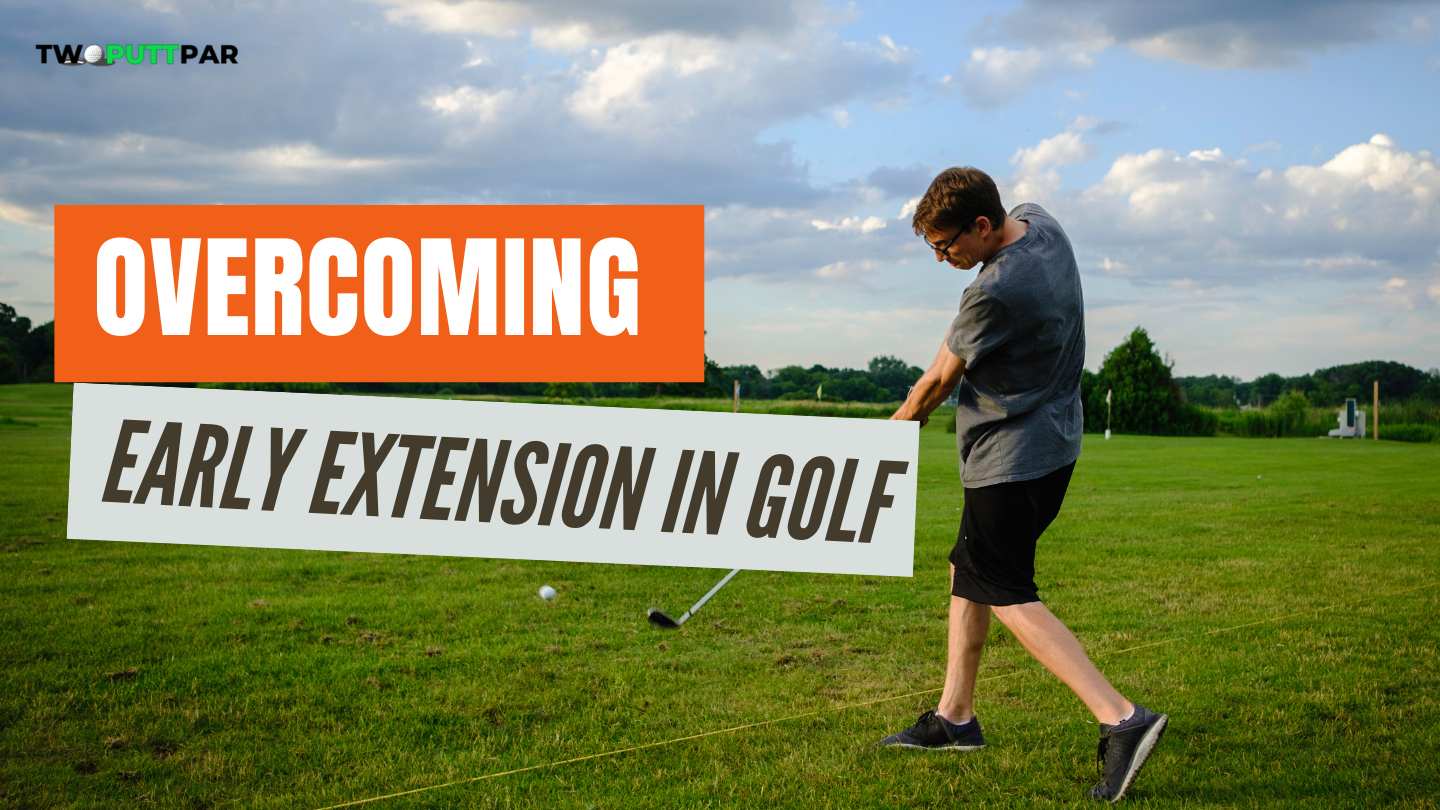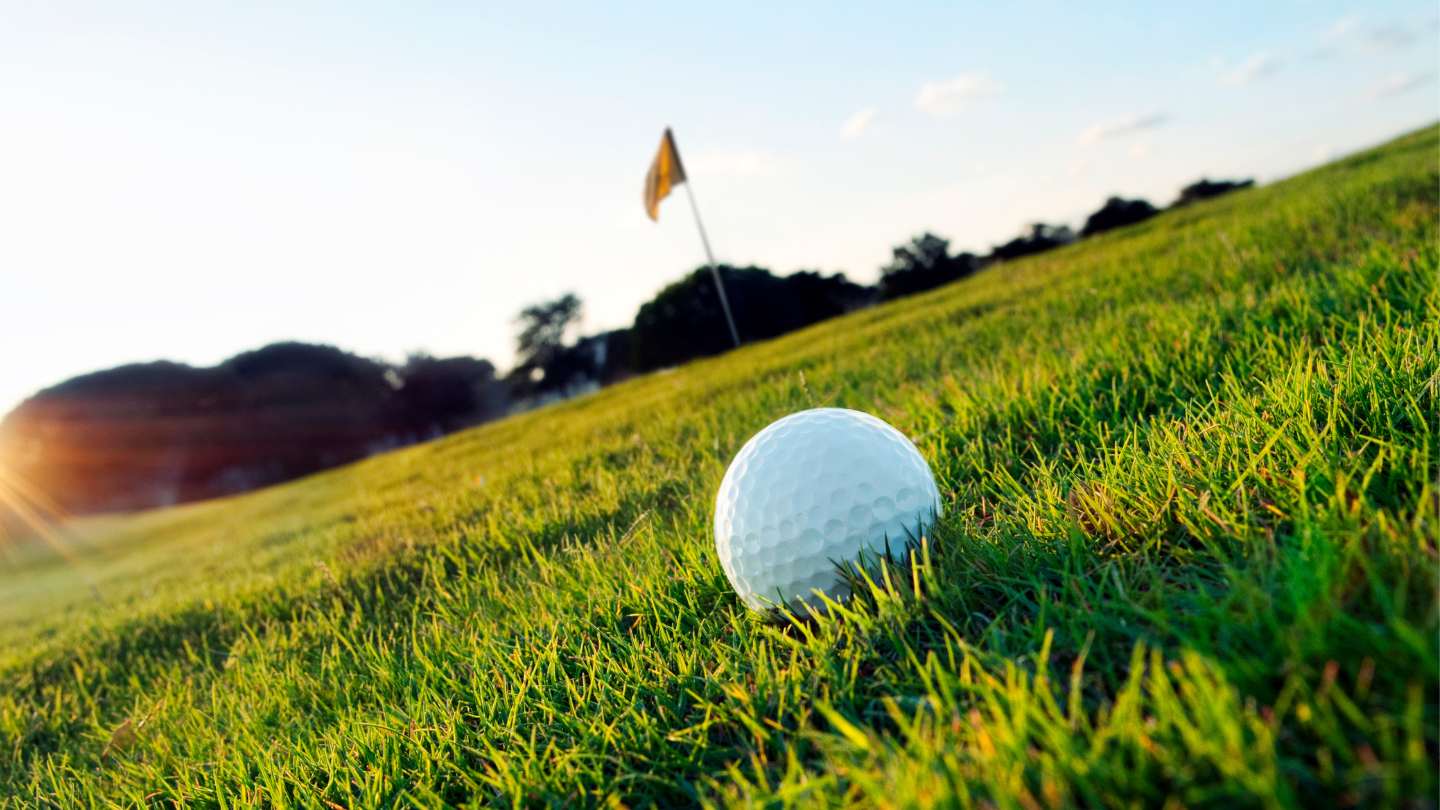
Mid-Handicap golfer who loves to share his rounds and experiences playing courses all around the UK in a hope that it will help others find those hidden gem golf courses.
I seek out golf courses that don’t get the credit they deserve and are often overlooked for the bigger more well known ones.
For those who are new to the sport, mastering your swing may seem like a daunting task.
In this article, we will discuss a common problem faced by golfers known as early extension and how to overcome it.
We will provide valuable tips and techniques to help you improve your swing and ultimately enhance your overall performance on the golf course.
Mastering your swing and overcoming early extension in golf involves maintaining the correct posture throughout the swing, ensuring your hips move correctly, and practising drills to reinforce the proper movements.
What is Early Extension in Golf?
Early extension in golf refers to any forward movement of the lower body towards the golf ball during the downswing, which can disrupt your swing’s consistency and effectiveness.
This common fault in a golfer’s swing is characterised by the shifting of the lower body towards the ball during the downswing, causing the head to move away from the ball while the hips move closer.
This can result in a range of issues, including loss of power, inconsistent contact, and directional control problems, leading to hooks or slices.
Key differences – Golf Slice vs Hook
Addressing early extension involves a few key aspects.
- Firstly, maintaining the correct spine angle throughout the swing is crucial. This helps to ensure that the hips move correctly and prevents them from thrusting towards the ball.
- Secondly, practising specific drills can be beneficial. For example, the glute bridge exercise can help strengthen the muscles required for a proper golf swing.
- Lastly, understanding the correct pressure shifts in your feet during the swing can also help eliminate early extension.
By focusing on these areas, golfers at all levels can work to overcome early extension, improving their swing’s consistency and efficiency.
Improving Your Golf Swing

Effective drills to fix early extension involve:
Slow Practice Swings
One of the effective methods to correct early extension is to practice your swing slowly.
By doing this at a reduced speed, you can pay close attention to your body’s movement and make necessary adjustments to prevent your lower body from moving towards the ball during the downswing.
As you become more comfortable with the correct movement, gradually increase your swing speed.
Using a Wedge for Ground Stability
Another drill involves using a golf wedge.
The idea is to position the wedge flat on the ground, which helps maintain stability during the swing. This stability can help you control your hip movement and prevent early extension.
Disassociation Planks
Disassociation planks are a physical exercise that can help improve your golf swing.
They work by strengthening the core muscles and improving body separation – both essential aspects of a good golf swing.
These exercises can help you maintain the right posture during your swing and prevent early extension.
Picket Fence Drill
The picket fence drill is another helpful method. This involves swinging the golf club while standing close to a physical barrier such as a picket fence or wall.
The aim is to execute the swing without hitting the barrier. This drill encourages a more vertical swing path, helping to combat early extension.
Correcting Your Golf Posture
Correcting your golf posture involves understanding its importance, knowing what a proper posture looks like, identifying common mistakes, and using drills to improve it, while also focusing on your upper body’s role in maintaining good posture.
Understanding the Importance of Golf Posture
Good golf posture is crucial for achieving a consistent and powerful swing.
It allows for the correct rotation of the upper body and facilitates the right weight shift throughout the swing. A good posture can also help prevent injuries by reducing the strain on your body during the swing.
Proper Golf Posture for a Consistent Swing
A proper golf posture involves standing tall with the feet shoulder-width apart, bending from the hips (not the waist), keeping your back straight, and allowing your arms to hang naturally.
Your weight should be balanced evenly on the balls of your feet. This posture promotes balance and stability, leading to a more consistent swing.
Common Mistakes in Golf Posture
Common mistakes in golf posture include slouching, bending from the waist instead of the hips, standing too far or too close to the ball, and leaning too much on the heels or toes.
These errors can disrupt your balance, limit the effectiveness of your swing, and even lead to injuries.
Drills to Improve Your Golf Posture
There are several drills that can help improve your golf posture.
One effective drill is the ‘mirror check’, where you practice your posture in front of a mirror to ensure your back is straight and you’re bending from the hips.
Another useful drill is the ‘wall touch’. Stand with your back against a wall, bend at the hips, and try to touch the wall with your fingertips. This helps reinforce the correct hip hinge motion.
The Role of Upper Body in Maintaining Good Posture
The upper body plays a significant role in maintaining good golf posture. The shoulders should be relaxed, the chest open, and the back straight.
The upper body’s correct positioning allows for a better rotation during the swing, leading to increased power and consistency.
Mastering The Golf Swing Sequence
Mastering the golf swing sequence involves understanding its components, ensuring proper timing, avoiding common errors, practising specific drills, and being aware of key checkpoints during the swing.
The golf swing sequence is a series of coordinated movements that include the address, takeaway, top of the backswing, transition, downswing, and impact.
Each stage plays a crucial role in executing a successful golf swing.
The clubhead, arms, torso/chest, and hips move in a specific order to generate power and control.
Proper Timing in the Golf Swing
Proper timing in the golf swing is essential for achieving maximum distance and accuracy.
It involves coordinating the movement of different body parts, starting with the hips, followed by the torso/chest, arms, and finally the clubhead.
This creates a ‘whipping’ effect, which generates power and speed.
Common Errors in the Swing Sequence
Common errors in the swing sequence can disrupt your swing’s effectiveness.
These include moving the club past parallel during the backswing, not shifting the hips towards the target during the downswing, and stopping the swing prematurely after impact. Correcting these errors can significantly improve your swing’s consistency and power.
Drills to Improve Your Swing Sequence
Drills to improve your swing sequence include one-arm swings to enhance shoulder control and mirror checks to ensure proper body alignment at each stage of the swing.
Practising slow-motion swings can also help you better understand and control your swing sequence.
Key Checkpoints in the Swing Sequence
Key checkpoints in the swing sequence include ensuring your club does not go past parallel at the top of the backswing, rotating your body through impact, and continuing your swing even after the ball has been hit.
Checking these points during your practice sessions can help you maintain a proper swing sequence.
Perfecting Your Golf Impact and Downswing
Perfecting your golf impact and downswing involves understanding the importance of a solid impact, developing a powerful downswing, practising specific drills, avoiding common mistakes, and learning how to create lag in your swing.
A solid golf impact is crucial because it determines the ball’s spin, trajectory, initial direction, and curve.
In the split second the golf ball is on the club face, it receives its ‘marching orders’. If the impact is off, even slightly, it can significantly affect the ball’s flight.
Developing a Powerful Downswing
Developing a powerful downswing is key to achieving distance and accuracy in your shots.
It’s about more than just swinging hard, though. Proper sequencing, where the lower body starts the downswing followed by the torso, arms, and finally the club, is essential for maximising power.
Drills to Improve Your Golf Impact and Downswing
Drills to improve your golf impact and downswing include the ‘pump drill’ to help establish proper sequencing, and the ‘towel drill’, where a towel is placed under your armpits to encourage a more connected swing.
Practising these drills can help you achieve a better impact position and a more powerful downswing.
Common Mistakes in the Downswing
Common mistakes in the downswing include over-swinging, where the golfer tries to hit the ball too hard, and ‘coming over the top’, where the club moves outside the ideal swing path.
These errors can result in inconsistent shots and reduced power.
Creating Lag in the Golf Swing
Creating lag in the golf swing involves maintaining the angle between your lead arm and the club shaft for as long as possible during the downswing.
This helps store energy that is then released at impact, generating extra clubhead speed and thus more distance.
Building a Consistent Golf Swing
Building a consistent golf swing involves focusing on tips for consistent ball striking, improving your grip, establishing a proper swing plane, managing weight shift in the swing, and practising simple drills for enhanced consistency.
Tips for Consistent Ball Striking
Consistent ball striking is fundamental to a reliable golf swing.
Key components include maintaining good rhythm throughout the swing, letting the club do its job rather than forcing it, and focusing on making solid contact with the lower back of the ball first.
It’s also important to understand the descending blow, which refers to hitting down on the ball to create optimal spin and trajectory.
Find out – How Much Does a Golf Ball Weigh?
Improving Your Golf Grip for a Better Swing
A solid golf grip is the foundation of a good swing.
The hands should be placed on the club in such a way that they can work together as a unit, with the club held more in the fingers than the palms. The pressure should be firm but not overly tight to allow for fluid wrist hinge and release.
Building a Proper Golf Swing Plane
The golf swing plane is the path that the clubhead follows during the swing.
A proper swing plane is critical for consistent ball striking and accuracy. It’s essential to ensure that the clubhead moves on an inclined circular path around the body, matching the angle of the club’s shaft at address.
Find out – When To Switch From Stiff To Regular Shaft?
Shifting Weight in the Golf Swing
Proper weight shift in the golf swing can significantly enhance power and consistency.
The weight should move to the back foot during the backswing and then shift forward to the front foot in the downswing, helping to generate power and ensure solid ball contact.
Simple Drills to Enhance Your Swing Consistency
There are several simple drills that can help enhance your swing consistency.
These include the ‘pressure drill’, where you focus on maintaining pressure on the trail leg during the downswing, and the ‘flex turn, push turn’ drill, which helps improve rotation and swing sequence for cleaner, more consistent contact.
FAQs
Q: How does early extension affect the golf swing?
A: Early extension can have a negative impact on the golf swing. It can cause the golfer to lose their posture, leading to inconsistent ball striking and loss of power. It can also make it difficult to rotate the hips properly, which can affect the swing sequence and timing.
Q: Are there any drills to help overcome early extension?
A: Yes, there are several drills that can help golfers overcome early extension. One common drill is the “wall drill” where the golfer stands with their back against a wall and practices swinging without touching the wall. This helps promote a more stable lower body and prevents early extension.
Q: How does the backswing affect early extension?
A: The backswing plays a role in early extension because it sets the foundation for the downswing. If a golfer has improper positioning or lack of rotation in the backswing, it can make it more difficult to maintain proper posture and prevent early extension in the downswing.
Q: Can the golf club choice affect early extension?
A: The choice of golf club can indirectly affect early extension. A golfer using a longer club may be more prone to early extension due to the extra weight and length of the club. However, early extension is primarily caused by swing mechanics rather than the club itself.
Q: How can I improve my swing speed and avoid early extension?
A: To improve swing speed and avoid early extension, it is important to focus on proper sequencing of the swing and maintaining good posture throughout. Regular practice of specific swing drills and exercises can also help improve swing speed and prevent early extension.
Q: What role does golf instruction play in overcoming early extension?
A: Golf instruction can be very beneficial in overcoming early extension. A qualified instructor can identify swing flaws and provide guidance on proper mechanics and drills to address early extension. They can also provide feedback and personalized instruction to help golfers make necessary adjustments.
Q: How does the golf grip affect early extension?
A: The golf grip can have an impact on early extension. A proper grip can help golfers maintain control and stability throughout the swing, reducing the likelihood of early extension. It is important to have a grip that allows for proper wrist hinge and control of the club throughout the swing.
Q: Can I still play golf with early extension?
A: Yes, it is possible to still play golf with early extension. However, it can affect your consistency and power in the swing. If you are experiencing early extension, it is recommended to work on improving your swing mechanics to minimize its impact on your game.
Q: Will fixing early extension improve my ball striking?
A: Yes, fixing early extension can improve your ball striking. By maintaining proper posture and sequencing in the swing, you will have better control over the club at impact, leading to more consistent and accurate ball striking.
Conclusion
From understanding the root cause of early extension to implementing specific drills and exercises, this blog post has provided valuable insights on how to overcome this common issue in golf.
By mastering your swing, you can improve your overall game and reduce the risk of injuries.
Affiliate Disclaimer – As an affiliate, we may earn a commission from qualifying purchases. We get commissions for purchases made through links on this website from Amazon and other third parties.





Leave a Reply